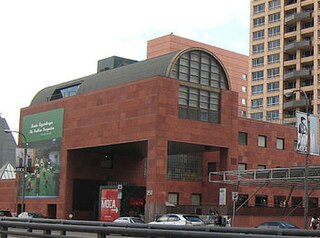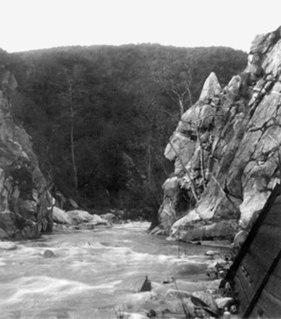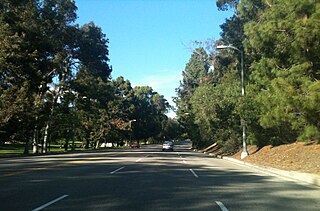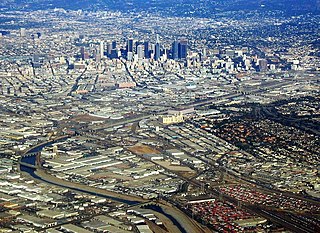
Venice is a residential, commercial, and recreational beachfront neighborhood within Los Angeles, California. It is located within the urban region of western Los Angeles County known as the Westside.

Southern California is a geographic and cultural region that generally comprises California's southernmost counties, and is the second most populous urban agglomeration in the United States. The region is traditionally described as eight counties, based on demographics and economic ties: Imperial, Los Angeles, Orange, Riverside, San Bernardino, San Diego, Santa Barbara, and Ventura. The more extensive 10-county definition, which includes Kern and San Luis Obispo counties, is also used and is based on historical political divisions.

Los Angeles County, officially the County of Los Angeles, is the most populous county in the Los Angeles metropolitan area of the U.S. state of California and is the most populous county in the United States, with more than 10 million inhabitants as of 2017. As such, it is the largest non–state level government entity in the United States. Its population is larger than that of 41 individual U.S. states. It is the third-largest metropolitan economy in the world, with a Nominal GDP of over $700 billion—larger than the GDPs of Belgium, Saudi Arabia, Norway, and Taiwan. It has 88 incorporated cities and many unincorporated areas and, at 4,083 square miles (10,570 km2), it is larger than the combined areas of Delaware and Rhode Island. The county is home to more than one-quarter of California residents and is one of the most ethnically diverse counties in the U.S. Its county seat, Los Angeles, is also California's most populous city and the nation's second largest city with about 4 million people.

The Academy of Country Music(ACM) was founded in 1964 in Los Angeles, California as the Country & Western Music Academy. Among the founders were Eddie Miller, Tommy Wiggins, and Mickey and Chris Christensen. They wanted to promote country music in the western 13 states with the support of artists based on the West Coast. Artists such as Johnny Bond, Glen Campbell, Merle Haggard, Roger Miller and others influenced them. A board of directors was formed to govern the academy in 1965.

Owens Valley is the now-arid valley of the Owens River in eastern California in the United States, to the east of the Sierra Nevada and west of the White Mountains and Inyo Mountains on the west edge of the Great Basin. The mountain peaks on either side reach above 14,000 feet (4,300 m) in elevation, while the floor of the Owens Valley is about 4,000 feet (1,200 m), making the valley one of the deepest in the United States. The Sierra Nevada casts the valley in a rain shadow, which makes Owens Valley "the Land of Little Rain." The bed of Owens Lake, now a predominantly dry endorheic alkali flat, sits on the southern end of the valley.

The San Fernando Valley is an urbanized valley in Los Angeles County, California in the Los Angeles metropolitan area, defined by the mountains of the Transverse Ranges circling it. Home to 1.77 million people, it is north of the larger, more populous Los Angeles Basin.

The Los Angeles County Museum of Art (LACMA) is an art museum located on Wilshire Boulevard in the Miracle Mile vicinity of Los Angeles. LACMA is on Museum Row, adjacent to the La Brea Tar Pits.

Downtown Los Angeles (DTLA) is the central business district of Los Angeles, California, as well as a diverse residential neighborhood of some 58,000 people. A 2013 study found that the district is home to over 500,000 jobs. It is also part of Central Los Angeles.

The Museum of Contemporary Art, Los Angeles (MOCA) is a contemporary art museum with three locations in greater Los Angeles, California. The main branch is located on Grand Avenue in Downtown Los Angeles, near the Walt Disney Concert Hall. MOCA's original space, initially intended as a "temporary" exhibit space while the main facility was built, is now known as the Geffen Contemporary, in the Little Tokyo district of downtown Los Angeles. The Pacific Design Center facility is in West Hollywood.

The Hammer Museum, which is affiliated with the University of California, Los Angeles, is an art museum and cultural center known for its artist-centric and progressive array of exhibitions and public programs. Founded in 1990 by the entrepreneur-industrialist Armand Hammer to house his personal art collection, the museum has since expanded its scope to become "the hippest and most culturally relevant institution in town." Particularly important among the museum's critically acclaimed exhibitions are presentations of both historically over-looked and emerging contemporary artists. The Hammer Museum also hosts over 300 programs throughout the year, from lectures, symposia, and readings to concerts and film screenings. As of February 2014, the museum's collections, exhibitions, and programs are completely free to all visitors.

The San Gabriel River is a mostly urban waterway flowing 58 miles (93 km) southward through Los Angeles and Orange Counties, California in the United States. It is the central of three major rivers draining the Greater Los Angeles Area, the others being the Los Angeles River and Santa Ana River. The river's watershed stretches from the rugged San Gabriel Mountains to the heavily developed San Gabriel Valley and a significant part of the Los Angeles coastal plain, emptying into the Pacific Ocean between the cities of Long Beach and Seal Beach.
The culture of Los Angeles is rich with arts and ethnically diverse. The greater Los Angeles metro area has several notable art museums including the Los Angeles County Museum of Art (LACMA), the J. Paul Getty Museum on the Santa Monica mountains overlooking the Pacific, the Museum of Contemporary Art (MOCA), the Hammer Museum and the Norton Simon Museum. In the 1920s and 1930s Will Durant and Ariel Durant, Arnold Schoenberg and other intellectuals were the representatives of culture, in addition to the movie writers and directors. As the city flourished financially in the middle of the 20th century, culture followed. Boosters such as Dorothy Buffum Chandler and other philanthropists raised funds for the establishment of art museums, music centers and theaters. Today, the Southland cultural scene is as complex, sophisticated and varied as any in the world.

The Arroyo Seco, meaning "dry stream" in Spanish, is a 24.9-mile-long (40.1 km) seasonal river, canyon, watershed, and cultural area in Los Angeles County, California. The area was explored by Gaspar de Portolà who named the stream Arroyo Seco as this canyon had the least water of any they had seen. During this exploration he met the Chief Hahamog-na (Hahamonga) of the Tongva Indians.

Elysian Park is a neighborhood in Central Los Angeles, California, encompassing Chavez Ravine, with a mostly low-income community of 2,600+ people. Besides the city park of the same name, Dodger Stadium is also located within the neighborhood, as are a Catholic high school, an elementary school and the Los Angeles Police Academy.

The Arts District is a neighborhood on the eastern edge of Downtown Los Angeles, California, United States. The gritty area has given new life to old industrial buildings whose history often dates to the early 20th century. While much of the early creative art was done behind closed doors, the street scene has slowly been activated in the early years of the 21st century as more and more factories are creatively reused with some new construction interspersed. Art galleries have opened and given recognition to the area amidst the entire downtown where Art museums and additional galleries can be found. The city community planning boundaries are Alameda Street on the west which blends into Little Tokyo, First Street on the north, the Los Angeles River to the east, and Violet Street on the south.
The California Art Club (CAC) is one of the oldest and most active arts organizations in California. Founded in December 1909, it celebrated its centennial in 2009 and into the spring of 2010. The California Art Club originally evolved out of The Painters Club of Los Angeles, a short-lived group that lasted from 1906–09. The new organization was more inclusive, as it accepted women, sculptors and out of state artists. Most of the major early California painters belonged to the CAC, including Franz Bischoff (1864–1929), Carl Oscar Borg (1879–1947), Edgar Payne (1883–1947), Julia Bracken Wendt (1868–1942), and William Wendt (1865–1946). As the members of the first generation of California Plein-Air Painters aged and died, the membership was filled by younger professional painters, including Millard Sheets (1907–1989), Mabel Alvarez (1891–1985), Emil Kosa, Jr. (1903–1968), and watercolorist Rex Brandt (1914–2000), along with amateur painters and commercial artists. Other notable members include Sir Winston Churchill (1874–1965), Dean Cornwell (1892–1960), Nicolai Fechin (1881–1955), Sam Hyde Harris (1889–1977), Alfredo Ramos Martinez (1872–1946), and Richard Neutra (1892–1970).
Located in Hollywood, Los Angeles Contemporary Exhibitions (LACE) is a nonprofit exhibition space and archive of the visual arts for the city of Los Angeles, California, United States, currently under the leadership of Sarah Russin.

Ace Hotel Downtown Los Angeles, originally built as the United Artists Building and later known as the Texaco Building, is a 243 ft (74 m), 13-story highrise hotel and theater building located at 937 South Broadway in downtown Los Angeles, California. It was the tallest building in the city for one year after its completion in 1927, and was the tallest privately owned structure in Los Angeles until 1956. Its style is Spanish Gothic, patterned after Segovia Cathedral in Segovia, Spain.















